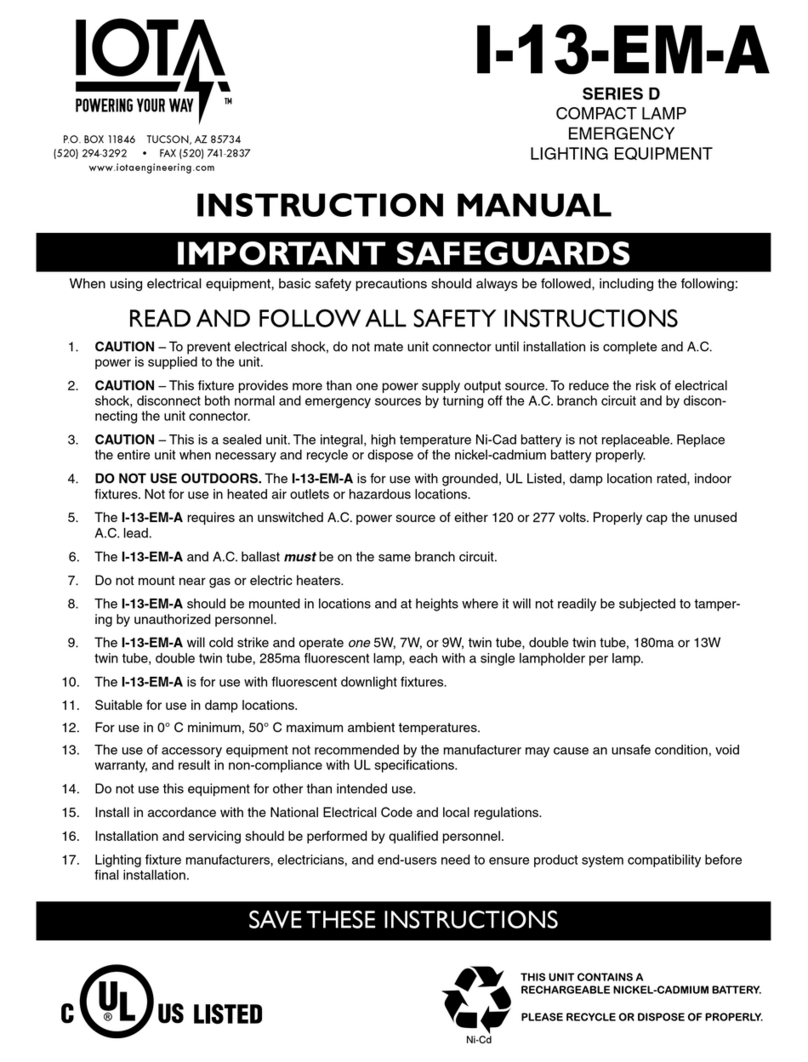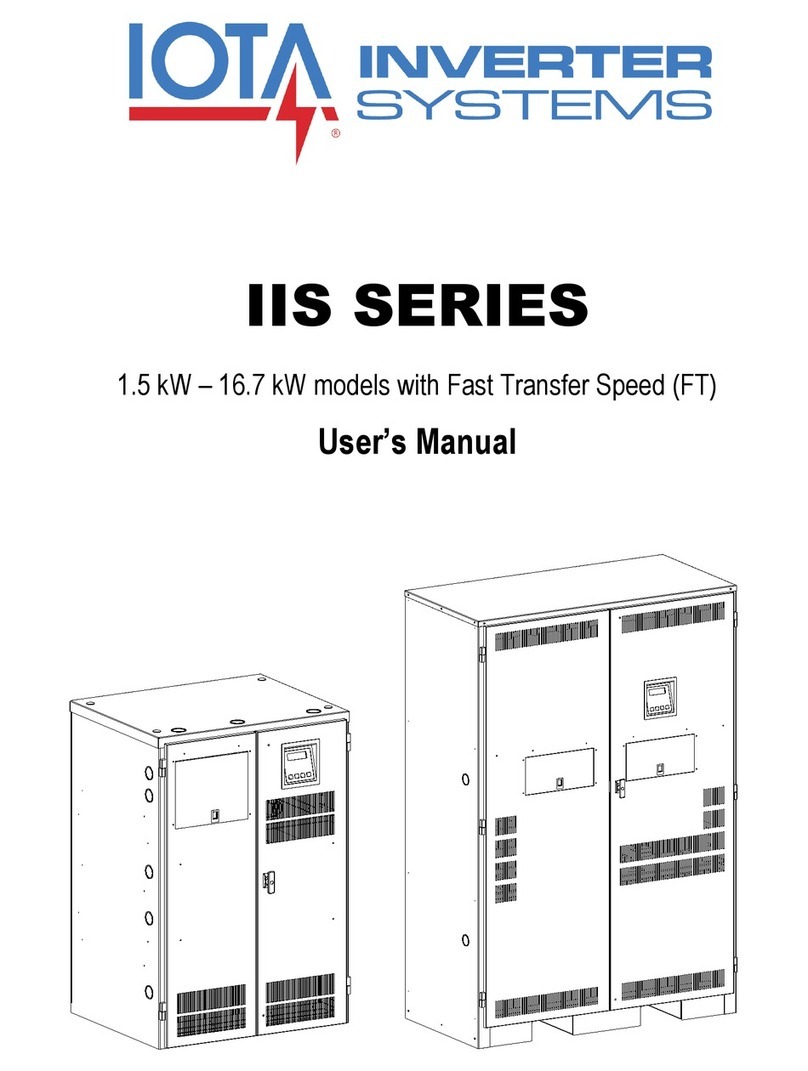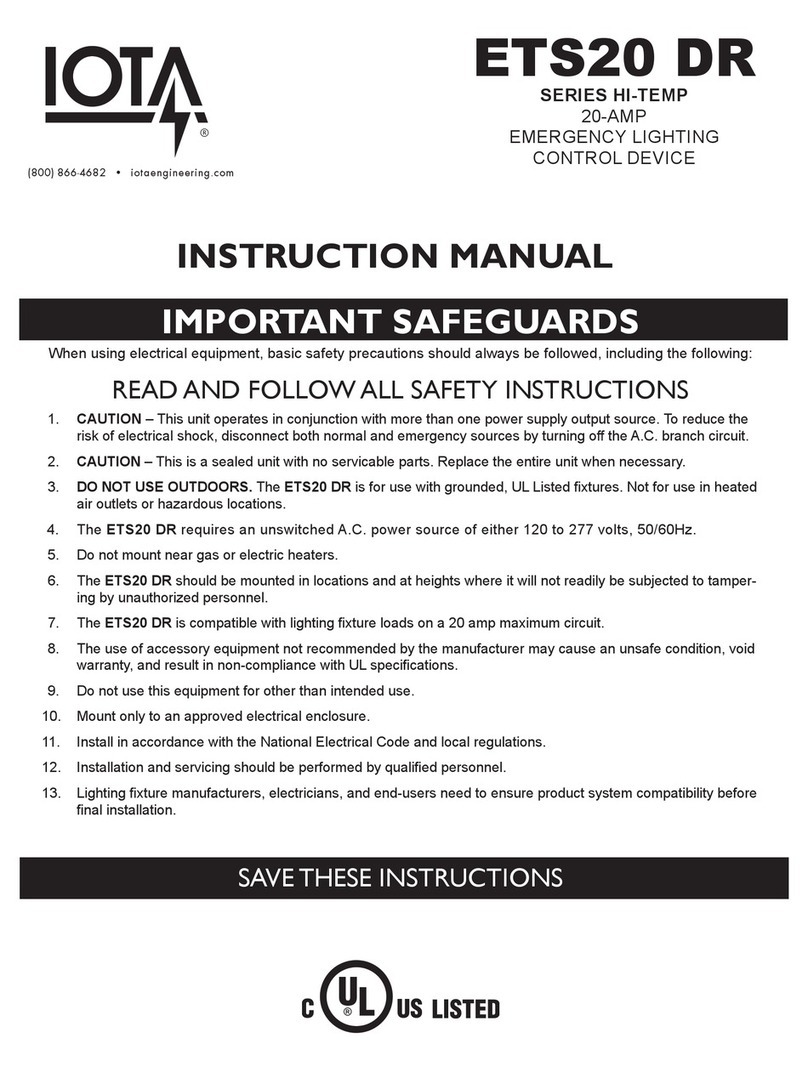
Page 3
2) Temporarily disconnect and cap the wire connected to the Normal Switch Sense lead on the ETS20.
This will disable the normal control function and allow testing of the “fail-to-ON” function.
3) Turn on the circuit breaker in the normal panel of the designated circuit. The Normal Power (Green) in-
dicator will be lit indicating that normal power is present and that emergency lighting is not required. Emer-
gency lighting should be o. Conrm automatic Emergency On operation by turning o the normal circuit
breaker. The emergency lighting should immediately turn on.
4) With the normal circuit breaker o, reconnect the wire to the Switch In lead. Turn on the normal circuit
breaker. The control device now controls both the normal and emergency lighting together.
Ready to Test Indicator
After installation of the remote switch or device (Section 3), the remote device should be in normal mode
(contacts closed) and the Ready to Test (Yellow) indicator on the ETS20 will be lit. When the remote device
is activated, or the remote test switch is pushed, the ETS20 bypasses the control device settings, allowing op-
eration of the emergency load. To conrm that the ETS20 is operating properly, set the wall switch or control
device in the ‘OFF’ position. Designated emergency xtures should come on when pressing the Test Button.
Note: for testing, the ETS20 will only bypass the control devices and operate the emergency xtures
from the normal supply - it does not activate nor conrm readiness of the auxiliary supply itself. The
Ready to Test (Yellow) indicator will extinguish and the Emergency Power (Red) indicator will remain lit.
If the Ready to Test Indicator is extinguished, it is an indication that Normal Power is lost or the unit is be-
ing forced into Emergency Power mode by the remote device or test switch. See Table A.
5. Labeling
Ax a self-adhesive caution label in a visible location on the enclosure and on each xture controlled by
the ETS20 noting that the load is supplied from both normal and emergency power sources. Both power
sources must be disconnected before servicing the xture(s).
OPERATION
Normal Mode –A.C. power is present. Fixtures are operating normally and all indicators on the ETS20 will be
lit: Normal Power (Green), Emergency Power (Red), and Ready to Test (Yellow). See Table A.
Emergency Mode – The A.C. power fails. The ETS20 senses the A.C. power failure and automatically activates
the emergency load. All designated xtures are illuminated at full light output for as long as auxiliary power is avail-
able regardless of the normal wall switch position. The Emergency Power Indicator (Red) on the ETS20 is lit and
the Normal Power (Green) and Ready to Test (Yellow) indicators are o. When the A.C. power is restored, the
ETS20 switches the system back to the Normal Mode. See page 1 of the Instruction Manual.
TESTING & MAINTENANCE
The ETS20 is a maintenance free unit, however, periodic inspection and testing is required. Refer to the NFPA
101, Life Safety Code and local codes for required emergency testing schedules.
Testing should be conducted following maintenance or re-working of any of the xtures connected to the emer-
gency circuit.
“Written records of testing shall be kept by the owner for inspection by the authority having jurisdiction.”
SERVICING SHOULD BE PERFORMED BY QUALIFIED PERSONNEL.
Consult Customer Service or visit www.iotaengineering.com for current warranty information.
READY TO TEST
(YELLOW)
NORMAL POWER
(GREEN)
EMERGENCY POWER
(RED)
ON
ON
ON
STATUS
DESCRIPTION
--
--
ON
All OK
Normal
Power
not present
Emergency
Power
not present
--
ON
ON --
--
--
Normal and
Emergency Power
not present
Test Button is pressed or
Fire Alarm/Remote Device
is open
ON
ON
--
TABLE A: ETS20 INDICATOR DESCRIPTIONS
























